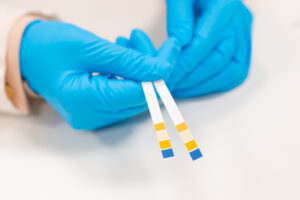Many people have received a prescription for Vicodin for various needs. Doctors mostly prescribe Vicodin to people with pain related issues, but it has a high potential to lead to dependence and eventually abuse. Most people will take Vicodin as prescribed. For short-term use, this usually causes no problems. However, people who need long-term pain relief for chronic pain may encounter issues with tolerance and an increased need for the medication in order to control their pain.
Almost everyone who starts taking a prescription medication intends to take it correctly. No one plans to develop substance abuse issues. At Everlast Recovery Centers, we help clients move past Vicodin addiction into a life of recovery.


Vicodin Addiction Rehab in Riverside, CA
Vicodin (hydrocodone/acetaminophen) is a combination of the narcotic hydrocodone, and non-narcotic pain reliever acetaminophen used to relieve moderate to moderately severe pain. The hydrocodone in Vicodin is a synthetic opioid, which activates the same neuroreceptors as opiate drugs such as heroin. Unlike substances made from natural opium, hydrocodone is a synthetic opioid made in a lab. While one might think lab-made substances would have less potential for harm, synthetic opioids can prove more dangerous than their natural counterparts.
Vicodin is currently labeled as a Schedule II controlled substance after being changed from Schedule III in October of 2014. Because the abuse potential of Vicodin and other hydrocodone combination drugs is so high, the DEA voted to tighten restrictions to protect individuals from abuse or misuse.
Misuse of Vicodin is constituted by any type of use without a prescription or other than directed by a doctor. It can be hard to recognize a Vicodin addiction, as it is a prescribed medication. Not everyone who develops a tolerance to or physical dependence on Vicodin will have a full opioid addiction. However, tolerance and dependence are diagnostic criteria for a substance use disorder. If an individual experiences tolerance or withdrawal symptoms when they stop using Vicodin, they should reach out to a medical professional to find the best course of action.
Side effects of Vicodin can include:
- Muscle relaxation
- Feeling calm or euphoric
- Dizziness
- Difficulty concentrating
- Impaired coordination
- Nausea and vomiting
Until better pain management tools become available, treating chronic pain with opiates must balance the natural process of building tolerance with the risk of the person becoming too dependent on the substance. People with chronic pain often report that they would prefer a pain relief method without the euphoric but cloudy-headed and drowsy feeling of opioids.

CHANGE YOUR
Therapeutic Services
How is Vicodin Addiction Treated?
When Vicodin has been prescribed to a person, and they have developed a problem with misusing it, contacting their prescribing doctor is a critical step in treatment. The doctor should provide details of the prescription and how the person’s tolerance may have escalated over time which may have led to misuse.
Withdrawal from any opiate should be monitored by clinically trained staff. However, those with a mild substance use disorder relating to Vicodin may not require residential care. To determine the best course of action, the individual should speak with a medical professional.

In a detox facility, a doctor will prescribe detox medications appropriate for that person, and staff will monitor them during their time in detox. If the person requires another method of pain management to cope with their chronic pain, the facility’s medical professionals can guide that person toward pain management resources. Options exist for treatment with or without substances. Buprenorphine, an opiate with unique properties that keep it from producing many side effects, may work for some people. Others may find relief with other therapies like a TENS unit to provide electrical stimulation to nerves.
Medication-Assisted Treatment (MAT) and Vicodin
For people who require pain management after they leave treatment, a medication like buprenorphine may help them treat pain and avoid urges to use other opiates. Medication-Assisted Treatment (MAT) may not be the best option for everyone, as buprenorphine does have a risk for dependence and abuse. For people who do not need pain management, their need for MAT will be a medical professional’s decision.

How Does Everlast Treat Vicodin Addiction?
At Everlast Recovery Centers, we treat each person’s journey into Vicodin addiction uniquely and individually. Vicodin, a controlled but legal substance, may have been prescribed by a doctor. The person may have begun using the medication under the circumstances, such as pain management. If the treatment goal must include pain relief, the person’s medical plan will differ from someone who used illicit Vicodin. By utilizing our individualized treatment approach, each client’s treatment plan at Everlast allows our clients to get the specific care they need to live a life free from substances.

Although the ultimate goal at Everlast is complete abstinence, some people may need to continue with some type of pain control. Chronic pain impacts every aspect of a person’s life, so our team works closely with the client’s medical care providers to make sure they have the appropriate pain management plan after they leave treatment.
With a client-centered philosophy, Everlast’s staff never judge people for which substance brought them to treatment. Each person has individual needs, and our clinically trained staff provides options like individual and group therapy, complementary activities including art therapy and yoga, and weekly visits with our medical doctor. At Everlast, we teach a lifetime of tools so anyone who wants to stop using opioids can live a life free from addiction.






